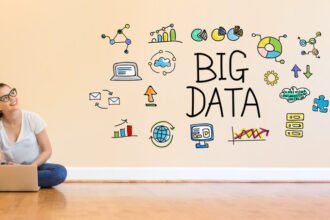 New technologies allow schools, colleges and universities to analyse absolutely everything that happens. From student behaviour, testing results, careers developments of students as well as educational needs based on changing societies.
New technologies allow schools, colleges and universities to analyse absolutely everything that happens. From student behaviour, testing results, careers developments of students as well as educational needs based on changing societies.
 New technologies allow schools, colleges and universities to analyse absolutely everything that happens. From student behaviour, testing results, careers developments of students as well as educational needs based on changing societies. A lot of these data has already been stored and is used for statistical analysis by government agencies such as the National Center for Educational Statistics. With the rise of more and more online education and the development of MOOC’s all the data gets a completely new meaning. Big data allow for very exciting changes in the educational field that will revolutionize the way students learn and teachers teach. To stimulate this trend, the US Department of Education (DOE) was part of a host of agencies to share a $200 million initiative to begin applying big data analytics to their respective functions, as described in a post by James Locus.
New technologies allow schools, colleges and universities to analyse absolutely everything that happens. From student behaviour, testing results, careers developments of students as well as educational needs based on changing societies. A lot of these data has already been stored and is used for statistical analysis by government agencies such as the National Center for Educational Statistics. With the rise of more and more online education and the development of MOOC’s all the data gets a completely new meaning. Big data allow for very exciting changes in the educational field that will revolutionize the way students learn and teachers teach. To stimulate this trend, the US Department of Education (DOE) was part of a host of agencies to share a $200 million initiative to begin applying big data analytics to their respective functions, as described in a post by James Locus.
Improve student results
The overall goal of big data within the educational system should be to improve student results. Better students are good for society, organisations as well educational institutions. Currently, the answers to assignments and exams are the only measurements on the performance of students. During his or her student life however, every student generates a unique data trail. This data trail can be analysed in real-time to deliver an optimal learning environment for the student as well to gain a better understanding in the individual behaviour of the students.
It is possible to monitor every action of the students. How long they take to answer a question, which sources they use, which questions they skipped, how much research was done, what the relation is to other questions answered, which tips work best for which student, etc. Answers to questions can be checked instantly and automatically (except for essays perhaps) give instant feedback to students.
In addition, big data can help to create groups of students that prosper due to the selection of who is in a group. Students often work in groups where the students are not complimentary to each other. With algorithms it will be possible to determine the strengths and weaknesses of each individual student based on the way a student learned online, how and which questions were answered, the social profile etc. This will create stronger groups that will allow students to have a steeper learning curve and deliver better group results.
Create mass-customized programs
All this data will help to create a customized program for each individual student. Big data allows for customization at colleges and universities, even if they have 10.000s of students. This will be created with blended learning; a combination of online and offline learning. It will give students the opportunity to develop their own personalized program, following those classes that they are interested in, working at their own pace, while having the possibility for (offline) guidance by professors. Providing mass customization in education is a challenge, but thanks to algorithms it becomes possible to track and assess each individual student.
We already see this happening in the MOOC’s that are developed around the world now. When Andrew Ng taught the Machine Learning class at Stanford University, generally 400 students participated. When it was developed as a MOOC at Coursera in 2011, it attracted 100.000 students. Normally this would take Andrew Ng 250 years to teach the same amount of students. 100.000 students participating in a class generate a lot of data that will deliver insights. Being able to cater for 100.000 students at once, also requires the right tools to be able to process, store, analyse and visualize all data involved in the course. At the moment, these MOOC’s are still mass made, but in the future they can be mass customized.
With 100.000 students participating in a MOOC, it will give universities the possibility to find the absolute best students from all over the world. Based on the individual behaviour of the students, their grades, their social profile and their networking skills algorithms can find the best students. These students can then receive a scholarship that will increase the overall level of the university.
Improve the learning experience in real-time
When students start working on their own, in their customized blended learning program, the vast amount of teaching, which most of the time is covered by general topics that have to appeal to all students from different levels, can be done online and by themselves. The professor can monitor all students in real-time and start a much more interesting and deeper conversation on the topic of choice. This will give students the possibility to gain a better understanding of the topics.
When students are monitored in real-time, it can help to improve the digital textbooks and course outlines that are used by the students. Algorithms can monitor how the students read the texts. Which parts are difficult to understand, which parts are easy and which parts are unclear. Based on how often a text is read, how long it takes to read a text, how many questions are asked around that topic, how many links are clicked for more information etc. If this information is provided in real-time, authors can change their textbooks to meet the needs of the students thereby improving the overall results.
Even more, big data can give insights in how each student learns at an individualized level. Each student learns differently and the way a student learns affects the final grade of course. Some students learn very efficiently while other may be extremely inefficient. When the course materials are available online, it can be monitored how a student learns. This information can be used to provide a customized program to the student or provide real-time feedback to become more efficient in learning and thus improve their results.
Reduce dropouts, increase results
All these analyses will improve the student results and perhaps also reduce dropout rates at universities or colleges. Dropouts are expensive for educational institutes as well as for society. When students are closely monitored, receive instant feedback and are coached based on their personal needs, it can help to reduce dropout rates as mentioned as well in a post by Hortonworks.
Using predictive analytics on all the data that is collected can give educational institute insights in future student outcomes. These predictions can be used to change a program if it predicts bad results on a particular program or even run scenario analysis on a program before it is started. Universities and colleges will become more efficient in developing a program that will increase results thereby minimizing trial-and-error.
After graduation, students can still be monitored to see how they are doing in the job market. When this information is made public, it will help future students in their decision when choosing the right university.
Big data will revolutionize the learning industry in the coming years. More and more universities and colleges are already turning to big data to improve overall student results. Smarter students who study faster will have a positive effect on organisations and society. Therefore, lets not wait and lets embrace big data in education!









